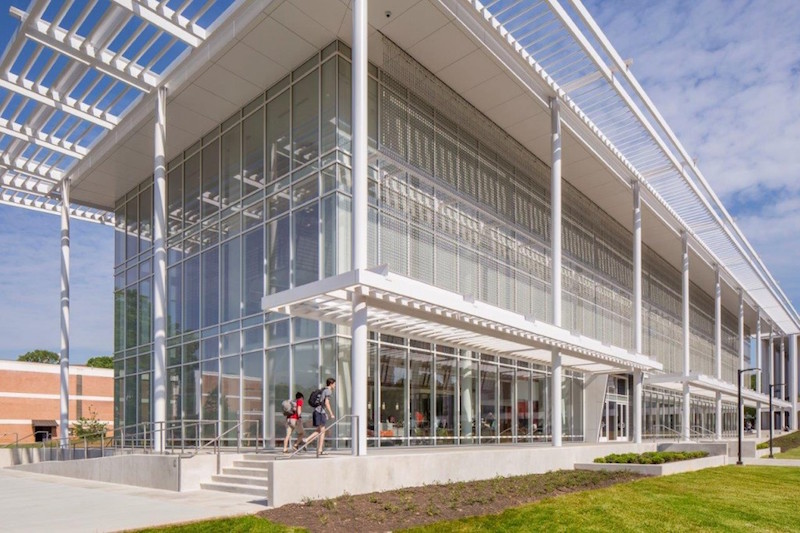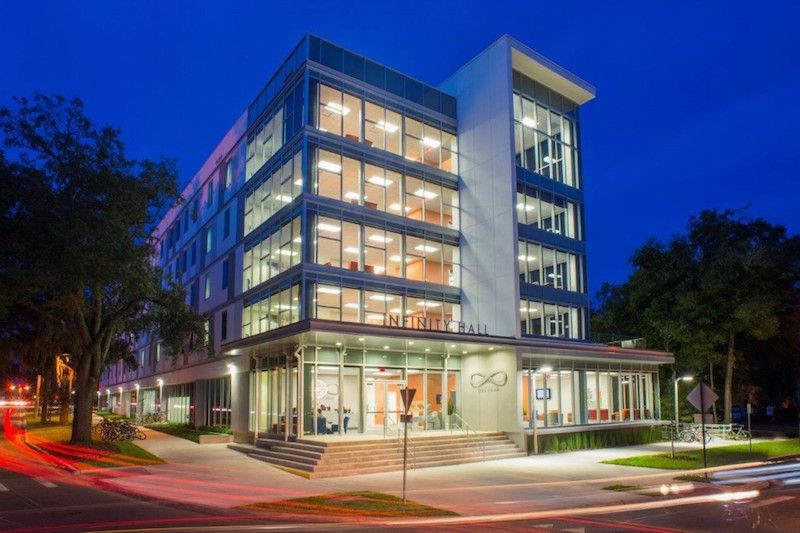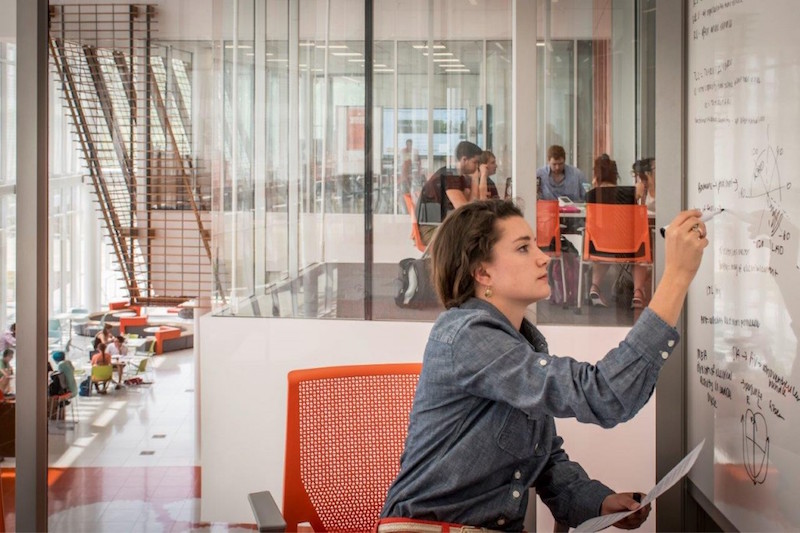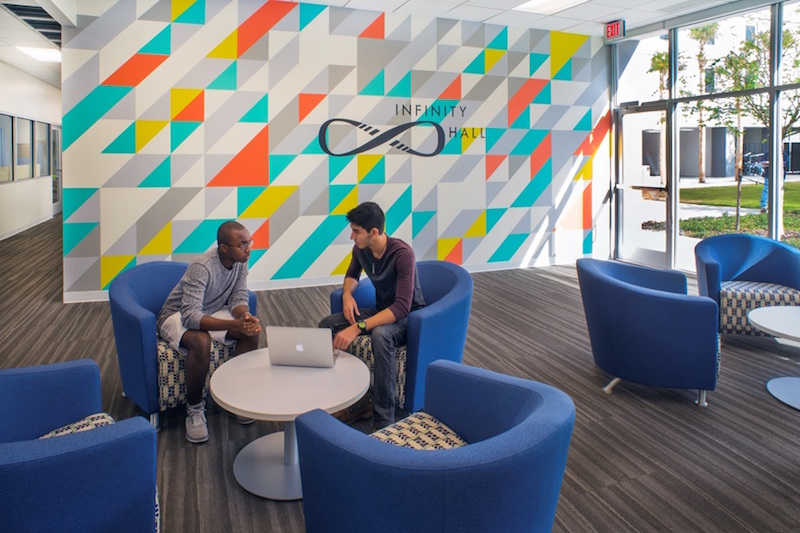The effort to remake higher education institutions into entrepreneurship and innovation hubs has escalated like a Cold War arms race. The promised payoffs of this innovation drive are institution-wide and community-deep: building relationships, aligning the institution, and preparing the organization as well as its students for transformational change. But how do you create space that can be messy and nonlinear in an institutional culture that is steeped in tradition, standards, and rules? It may be that pursuing effective university-driven innovation programs and facilities will involve equally innovative strategic approaches to design and development—for example, decoupling innovation centers from any single departmental steward and, perhaps, from institutional ownership overall.
Planning for places that foster effective innovation is still an emerging process, but the constant pressure on universities to do so continues from two of their key institutional constituencies—students and employers.
Generations Y and Z—and the expectations of their parents— are primarily sparking the innovation drive on campus. As the most digitally connected group in history, Generation Z students are preconditioned to massive disruption and uncertainty. Concerned that traditional career approaches cannot be trusted, they are highly motivated to build innovation skills and exercise their entrepreneurial interests— perhaps even more than their Generation Y predecessors.
The second group driving the growth of university innovation centers is the marketplace of corporate employers who recruit on campus. They require a workforce of more agile thinkers who can apply an owner’s mind-set and work ethic to ever-shifting market needs. More than ever, employers are evaluating job candidates on more than just grades— they want students who demonstrate leadership, critical thinking, and communication skills.
Colleges and universities are the natural connecting point for these trends. In the competition to demonstrate innovation mastery, university faculty and pedagogy need supporting infrastructure and technology. Campus design and architecture will be the prime catalysts for transforming universities into our society’s engines of growth.
BREAKING DOWN SILOS TO FOSTER INNOVATION AT CLEMSON UNIVERSITY
Clemson University’s Watt Family Innovation Center (WFIC) demonstrates the results of an intentionally nontraditional planning decision that has influenced the program’s success to date. The institution determined that no one college or department should “own” the center, which is—practically and symbolically—situated in neutral territory near the very center of the Clemson campus. The center’s independence frees it to bring together a diverse set of students to collaborate and innovate and to serve as a powerful cross-university resource.
 Courtesy of Perkins+Will
Courtesy of Perkins+Will
Clemson gave the design team behind the WFIC the imperative to foster “engaged learning” and showcase the university’s Creative Inquiry program. The program provides faculty, students, and the broader community a hands-on, interactive, engaged learning environment in which to collaborate on real-world projects ranging from aquaculture to bioengineering, digital media to industrial engineering. The WFIC also serves as a highly visible unifying force for the myriad innovation programs percolating at Clemson including the Clemson Innovation Network, the Design and Entrepreneurship Network, and the Arthur M. Spiro Institute for Entrepreneurial Leadership.
With the goal of elevating the impact and reputation of Clemson’s research, innovation, and creativity, the center’s oversized windows and ultra-modern open space provide a dynamic sense of transparency. Its easily movable furnishings, reconfigurable partitions, powered-over-Ethernet lighting, and high-speed virtual network connections provide the flexibility necessary to scale, pivot, and advance innovation. The WFIC is also configured with $12 million in advanced audio/ visual technology to allow students, faculty, and leaders from industry and government agencies to collaborate, generate big ideas, and solve complex problems.
 Courtesy of Perkins+Will
Courtesy of Perkins+Will
CREATING INNOVATIVE POSSIBILITIES THROUGH UNIQUE PARTNERSHIP AT THE UNIVERSITY OF FLORIDA
The University of Florida (UF) has taken a different approach to cultivating innovation and entrepreneurship for tomorrow’s students. It has taken on the role of city builder.
Nestled between the university campus and downtown Gainesville, UF’s Innovation Square is a 40-acre urban master plan for a modern live/work/play research and innovation community intended to link university research with commercial opportunity and lure smart, young talent to the campus and community.
The new Infinity Hall is billed as an “Entrepreneurial Living Learning Community,” a five-story, 97,000-square-foot combination dorm and new venture incubator for over 300 students. While Infinity Hall is open to all UF undergraduates, it is especially focused on housing Innovation Academy participants. Innovation Academy is a four-year undergraduate program in which students can combine any one of 30 majors with a minor curriculum emphasizing creativity, entrepreneurship, leadership, and innovation.
 Courtesy of Perkins+Will
Courtesy of Perkins+Will
The desire for housing that fostered innovation and entrepreneurship, in addition to serving as a source of funding, took the Infinity Hall project out of the traditional university planning process. Infinity Hall was conceived as a public-private partnership located off-campus in Innovation Square. This approach freed the facility from the constraints on entrepreneurial space usage that would have existed if UF went with standard state bond financing, direct ownership, and on-campus development.
Opening space on Infinity Hall’s first floor to allow nonresidents to provide relevant services was an important part of the project. The public-private partnership scenario made it easier for the Infinity Hall team to get the right kind of support needed to make this hybrid education-entrepreneurship, living-learning space succeed. While many of these components were developed internally, many others were realized with the help of commercial partners or other departments at the university.
Further, locating the facility within Innovation Square directly addressed a standard challenge for university planners: how to adequately address the “town and gown” issues involved in relating to the community, especially at the edges of campus. Infinity Hall serves as another level of bridge between UF and other parts of the Gainesville community.
DELIVERING ON PROMISED PAYOFFS
The significant number of students who are deeply engaged in their work in the space is the biggest proof of success for both the Clemson and University of Florida facilities. In its first full semester, the Watt Family Innovation Center is home to at least 60 different courses representing 29 academic departments across all of Clemson’s colleges. There are more than 3,000 Clemson students taking courses in the center and still more students using the small team rooms and collaboration areas in the hallways.
At the University of Florida, Infinity Hall has seen similar immediate success. Last August, for instance, two freshmen who met for the first time as residents of Infinity Hall launched Peru+You, a food product company representing Peruvian culture, beginning with their own brand of Canchita—a corn kernel product—that they now sell at local farmers’ markets as they pursue online and retail distribution.
With success stories like these, it is safe to say that tomorrow’s students are responding positively to the bets placed by major colleges and universities on innovation and entrepreneurship. Equally encouraging is how these institutions are thinking like entrepreneurs themselves: fully using all the resources at their disposal—including their physical and facility assets—and breaking free of prior planning paths to accomplish big goals and become engines for growth.
To read the full article, visit the Society for Campus and University Planning.
Related Stories
Higher Education | Apr 17, 2023
Rider University opens a 'Zen Den' for restoring students' mental well-being
Rider University partnered with Spiezle Architectural Group to create a relaxation room for students, dubbed "The Zen Den."
Higher Education | Apr 13, 2023
Higher education construction costs for 2023
Fresh data from Gordian breaks down the average cost per square foot for a two-story college classroom building across 10 U.S. cities.
Urban Planning | Apr 12, 2023
Watch: Trends in urban design for 2023, with James Corner Field Operations
Isabel Castilla, a Principal Designer with the landscape architecture firm James Corner Field Operations, discusses recent changes in clients' priorities about urban design, with a focus on her firm's recent projects.
Market Data | Apr 11, 2023
Construction crane count reaches all-time high in Q1 2023
Toronto, Seattle, Los Angeles, and Denver top the list of U.S/Canadian cities with the greatest number of fixed cranes on construction sites, according to Rider Levett Bucknall's RLB Crane Index for North America for Q1 2023.
University Buildings | Apr 11, 2023
Supersizing higher education: Tracking the rise of mega buildings on university campuses
Mega buildings on higher education campuses aren’t unusual. But what has been different lately is the sheer number of supersized projects that have been in the works over the last 12–15 months.
Contractors | Apr 10, 2023
What makes prefabrication work? Factors every construction project should consider
There are many factors requiring careful consideration when determining whether a project is a good fit for prefabrication. JE Dunn’s Brian Burkett breaks down the most important considerations.
Smart Buildings | Apr 7, 2023
Carnegie Mellon University's research on advanced building sensors provokes heated controversy
A research project to test next-generation building sensors at Carnegie Mellon University provoked intense debate over the privacy implications of widespread deployment of the devices in a new 90,000-sf building. The light-switch-size devices, capable of measuring 12 types of data including motion and sound, were mounted in more than 300 locations throughout the building.
Collegiate Stadiums | Apr 4, 2023
6 examples of modern college training facilities
HOK discusses the future of college training facilities, with six design takeaways derived from a discussion between Dan Radakovich, Director of Athletics at the University of Miami, and Trevor Bechtold, Director, HOK’s Sports + Recreation + Entertainment practice.
Education Facilities | Apr 3, 2023
Oklahoma’s Francis Tuttle Technology Center opens academic center for affordable education and training
Oklahoma’s Francis Tuttle Technology Center, which provides career-specific training to adults and high school students, has completed its Francis Tuttle Danforth Campus—a two-story, 155,000-sf academic building. The project aims to fill the growing community’s rising demand for affordable education and training.
Designers | Mar 28, 2023
Inclusive design requires relearning how we read space
Pulling from his experience during a campus design workshop, David Johnson, AIA, LEED AP, encourages architects to better understand how to design spaces that are inclusive for everyone.
















